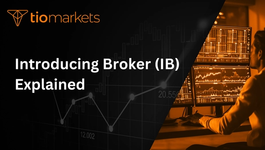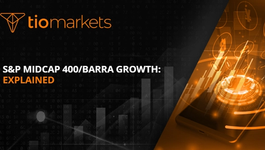Mid Cap Definition and Examples TIOmarkets
BY TIOmarkets
|June 3, 2024Exploring the realm of investment opportunities, mid-cap companies stand out as a compelling option for investors seeking a balance between the rapid growth potential of small-cap stocks and the stability of large-cap companies. This article delves into the essence of mid-cap entities, offering insights into their definition, characteristics, and examples to illuminate their role in a diversified investment portfolio.
Understanding Mid Cap Companies
Mid-cap companies, often characterized by their market capitalization, represent a middle ground in the investment landscape. They are neither as large and well-established as the giants of the industry nor as small and volatile as emerging startups. Here, we explore the defining aspects of mid-cap companies and why they are considered a golden mean in the world of investing.
Definition of Mid Cap
Market capitalization, or market cap, is the primary criterion for classifying companies into small, mid, and large-cap categories. Mid-cap companies are typically defined as those with a market capitalization ranging from $2 billion to $10 billion. This valuation reflects the company's total market value of its outstanding shares and serves as a gauge for investors to assess its size and potential for growth.
It's important to note that the thresholds for these categories can vary slightly among different financial institutions and analysts, but the aforementioned range is widely accepted as a standard for mid-cap classification.
Characteristics of Mid Cap Companies
Mid-cap companies are distinguished by several key characteristics that set them apart from their small and large-cap counterparts. Firstly, they often exhibit a balance of growth potential and stability. While not as established as large-cap companies, mid-caps usually have a proven track record of success and a clearer path to expanding their market share and operations.
Secondly, mid-cap companies tend to be more agile and adaptable than larger corporations, allowing them to respond more swiftly to market changes and opportunities. However, they also maintain a level of financial stability and resources that smaller companies may lack, reducing their risk of volatility.
Advantages of Investing in Mid Cap Stocks
Investing in mid-cap stocks offers a unique set of benefits, making them an attractive option for many investors. From growth potential to diversification, let's explore the advantages that mid-cap investments can bring to a portfolio.
Growth Potential
Mid-cap stocks often reside in the sweet spot of investment growth potential. They have already surpassed the initial hurdles that small-cap companies face but still have ample room for expansion and appreciation. This growth potential can lead to significant returns for investors who are able to identify successful mid-cap companies early in their growth trajectories.
Diversification Benefits
Adding mid-cap stocks to an investment portfolio can enhance diversification, reducing the risk associated with market volatility. Mid-caps' unique position between small and large caps allows them to contribute to a portfolio's balance, offering a blend of growth and stability that can protect against the fluctuations of the market.
Examples of Mid Cap Companies
To illustrate the concept of mid-cap companies, let's look at a few examples. These companies exemplify the balance of stability and growth potential that mid-caps are known for.
Example 1: Tech Innovator
A technology company that has developed a niche software product and has a market capitalization of $5 billion. This company has established a solid customer base and is in the process of expanding its market reach, making it a quintessential mid-cap stock with growth potential.
Example 2: Retail Chain
A regional retail chain valued at $3 billion, with a strong presence in several states and plans for national expansion. The company's established brand and expansion plans position it as a promising mid-cap investment.
Risks and Considerations
While mid-cap stocks offer attractive growth potential, investors should also be aware of the risks involved. Market volatility, competitive pressures, and economic factors can impact the performance of mid-cap companies. It's crucial for investors to conduct thorough research and consider their risk tolerance when incorporating mid-cap stocks into their investment strategy.
Market Volatility
Mid-cap stocks can be subject to higher market volatility compared to large-cap stocks. Economic downturns, industry shifts, and other external factors can affect mid-cap companies more significantly, potentially leading to abrupt price changes.
Competitive Pressures
Mid-cap companies often operate in competitive industries, facing challenges from both larger companies with more resources and smaller, more agile competitors. Staying competitive requires continuous innovation and strategic planning, which can pose risks to their growth and stability.
Impact of Economic Conditions on Mid Cap Companies
Economic conditions play a significant role in shaping the performance of mid-cap companies. During periods of economic growth, mid-cap stocks may experience increased investor interest and higher valuations. This positive economic environment can fuel the expansion plans of mid-cap companies, leading to enhanced profitability and stock price appreciation.
Conversely, in times of economic downturns or recessions, mid-cap companies may face challenges such as reduced consumer spending, tighter credit conditions, and overall market uncertainty. These factors can impact the growth trajectory of mid-cap stocks and test their resilience in adverse economic conditions.
Consumer Confidence and Spending Patterns
Consumer confidence levels are closely linked to the performance of mid-cap companies, especially those operating in consumer-facing industries. High consumer confidence typically translates to increased spending, benefiting mid-cap companies that rely on consumer demand for their products and services.
Conversely, a decline in consumer confidence can lead to reduced spending, impacting the revenue and profitability of mid-cap companies. Understanding consumer sentiment and spending patterns is crucial for investors evaluating the potential risks and opportunities associated with mid-cap investments.
Interest Rates and Financing Costs
Fluctuations in interest rates can have a significant impact on mid-cap companies, particularly in terms of financing costs and capital allocation decisions. When interest rates are low, mid-cap companies may find it more affordable to borrow funds for expansion projects or operational needs.
However, rising interest rates can increase borrowing costs, potentially affecting the profitability and growth plans of mid-cap companies. Investors monitoring interest rate trends should consider the implications for mid-cap stocks in their portfolios and adjust their investment strategies accordingly.
Regulatory Environment and Compliance Challenges
The regulatory environment in which mid-cap companies operate can influence their business practices, compliance requirements, and overall operational efficiency. Changes in regulations, industry standards, or government policies can pose challenges for mid-cap companies, requiring them to adapt their strategies and processes to remain compliant.
Compliance challenges can range from data privacy regulations and financial reporting requirements to environmental standards and labor laws. Mid-cap companies must stay abreast of regulatory developments and proactively address compliance issues to mitigate risks and maintain the trust of investors and stakeholders.
Impact of Regulatory Changes
Regulatory changes can have a direct impact on the operations and financial performance of mid-cap companies. For instance, new regulations related to data protection may require mid-cap tech companies to invest in cybersecurity measures and compliance frameworks, increasing their operational costs.
Similarly, changes in tax laws or trade policies can affect the profitability and competitiveness of mid-cap companies operating in global markets. By monitoring regulatory developments and assessing their implications, investors can better understand the risks and opportunities associated with investing in mid-cap stocks.
Compliance Risks and Governance Practices
Effective governance practices are essential for mid-cap companies to navigate compliance risks and uphold ethical standards in their operations. Establishing robust internal controls, transparent reporting mechanisms, and independent board oversight can help mitigate compliance risks and enhance the credibility of mid-cap companies in the eyes of investors.
Investors evaluating mid-cap stocks should consider the governance practices and compliance track record of companies in their investment analysis. Companies with strong governance structures and a commitment to regulatory compliance are better positioned to weather challenges and sustain long-term growth.
In conclusion, mid-cap companies offer a unique blend of growth potential and stability, making them an attractive option for diversified investment portfolios. By understanding the characteristics, advantages, and risks associated with mid-cap stocks, investors can make informed decisions to achieve their financial goals. As with any investment, due diligence and a balanced approach are key to navigating the opportunities and challenges presented by mid-cap companies.
Start Trading Mid-Cap Stocks with TIOmarkets
Ready to diversify your portfolio with the growth potential and stability of mid-cap stocks? Join TIOmarkets, a top-rated forex broker and online trading platform, and gain access to over 300 instruments across 5 markets. With low fees and a global presence in over 170 countries, we empower you to trade Forex, indices, stocks, commodities, and futures markets confidently. Enhance your trading skills with our comprehensive educational resources and step-by-step guides. Don't miss out on the opportunity to grow with mid-cap companies. Create a Trading Account today and start your journey towards successful investing.

Risk disclaimer: CFDs are complex instruments and come with a high risk of losing money rapidly due to leverage. You should consider whether you understand how CFDs work and whether you can afford to take the high risk of losing your money. Never deposit more than you are prepared to lose. Professional client’s losses can exceed their deposit. Please see our risk warning policy and seek independent professional advice if you do not fully understand. This information is not directed or intended for distribution to or use by residents of certain countries/jurisdictions including, but not limited to, USA & OFAC. The Company holds the right to alter the aforementioned list of countries at its own discretion.
Join us on social media

Behind every blog post lies the combined experience of the people working at TIOmarkets. We are a team of dedicated industry professionals and financial markets enthusiasts committed to providing you with trading education and financial markets commentary. Our goal is to help empower you with the knowledge you need to trade in the markets effectively.





